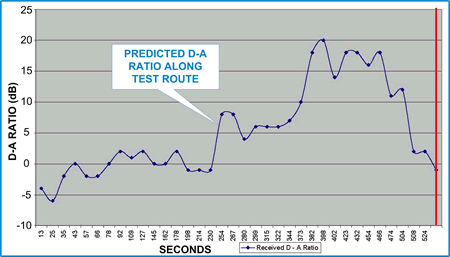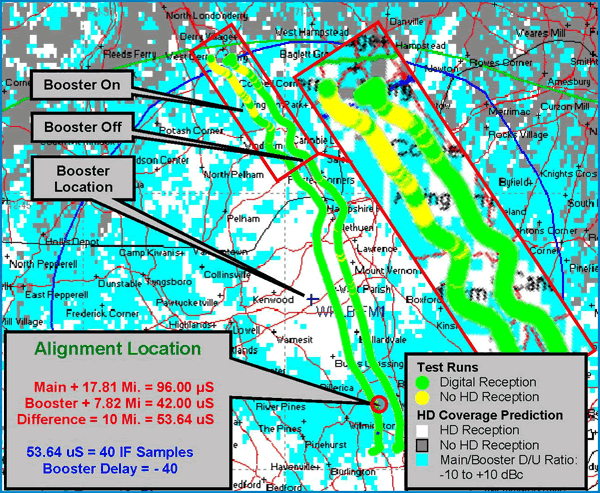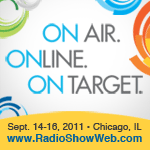
|
Digital boosters are used to form part of what is called a Single Frequency Network (SFN) which, briefly, involves transmitting identical radio signals in relatively close proximity using the same RF channel. SFNs are very difficult to establish using analog FM technology because at the receiver, multiple analog signals tend to behave just like multipath interference except in limited areas where the timing between signals has been precisely aligned. Digital radio systems (like the HD Radio system) which utilize Orthogonal Frequency Division Multiplexing (OFDM) modulation are designed to tolerate (and even use to advantage) the multipath interference created in an SFN and hence SFNs can be used for extending or filling in digital coverage areas. Predicted and measured results for the main signal plus digital-only booster case are shown in the above figure. The white and gray squares in the figures are the computer prediction of where an IBOC receiver would successfully capture the digital signal (white squares) or where the receiver would have blended to analog (gray squares). The light blue squares are areas where a main-to-booster digital power ratio of -10 to +10 dB are predicted. Also shown are the 54 dBu predicted contours of the main (green line) and booster (blue line) transmitter. Two separate test runs (of the same route) are shown in the figure side-by-side: one made with the booster on (left track) and one made with the booster off (right track). A close-up view of these runs is shown in the rectangular box to the right. Green dots indicate digital reception was available while yellow dots indicate no digital reception (and that the receiver had blended to analog). Note that in this figure there are no signal outages in the area between the sites – this is the area where signal reinforcement is occurring (the main WKLB transmitter location is below the booster location but too far away to be shown on this map). Also note that the edge-of-coverage performance with the booster on is worse than that of the main site in use alone. Since time alignment was set in the overlap area between the two sites, areas of equal signal level past the booster will not be time-aligned, as the delay is close to the theoretical maximum allowable of 75 µS. Overlap on both sides of the booster rarely occurs in real-world implementations, however. Additional test results discussing the impact of adding a small amount of analog signal to the booster are included in the final report as well. One issue with the operation of a digital-only booster is that, in the vicinity of the booster itself, the digital-to-analog power ratio of the hybrid IBOC signal is significantly higher than the -20 to -10 dB range the HD Radio system is designed for. In other words, right near the booster the digital signal can “overpower” the analog portion of the IBOC signal which is only being sent from the main transmitter and consequently adversely affect signal reception in analog-only devices. These additional tests were designed to determine whether some additional analog signal could improve analog reception right near the booster. The analog reception performance of two automotive receivers (a Delphi and an OEM Chrysler) as impacted by the presence or absence of the additional analog signal (from the booster) is discussed in the report. In the “digital-only” booster test, the Delphi was able to filter out most analog interference from the IBOC subcarriers, even at effective digital-to-analog power ratios of +20 dB. iBiquity suggests that this receiver has the attributes of a well-designed, modern, analog and HD Radio automotive receiver, but notes that even modern receivers are likely to experience some impairment locations closer than one mile from the booster. The older Chrysler receiver did not fare as well, exhibiting audible interference throughout its test run. Close to the booster, the audio was all but inaudible. 
When a small amount of analog signal was added at the booster, the results were mixed. Using this approach, with similar main and booster analog signal levels, the receivers suffered from the multipath-like interference characterized by FCC 47 CFR Section 74.1203(c). This problem was exacerbated for these tests by the efficiency of an excellent (booster) transmit antenna at the top of a 320-foot tower. Even the Delphi receiver was unable to mitigate the multipath effect of two combined, co-channel-modulated, FM-hybrid, IBOC signals. iBiquity has released three recordings of the analog audio from the Delphi and Chrysler receivers made during these test runs which will be posted in the near future on the NAB FASTROAD website. Two of these recordings were made with the digital-only booster in operation and the third with the hybrid (digital plus analog) booster in operation. Each recording also includes synchronized video of a predicted digital-to-analog power ratio graph similar to the one shown here; as the audio recording progresses, the vertical red line in the graph moves to indicate which part of the test run is being heard (in the figure, the red line is located at the end of the test run). NAB FASTROAD (Flexible Advanced Services for Television & Radio On All Devices) is the technology advocacy program of the National Association of Broadcasters. The overall mission of the FASTROAD program is to seek and facilitate development and commercialization of new technologies that can be exploited by broadcasters using radio and television broadcast spectrum. Copies of all three digital booster test reports are available for download free-of-charge from the FASTROAD web site at www.nabfastroad.org. |
|
Studio/Production
Day at the Radio Show During Studio Production Day, September 14 at the upcoming Radio Show, engineers will learn details about the trend toward multiplatform operations. Many stations are now embracing new technologies and looking beyond traditional broadcasting in order to capture new listeners and clients. The day's presentations are case studies from broadcasters who are incorporating new design ideas into their studios in order to provide flexibility for air talent, program-related social media activities, TV/Web integration and more. Jim Stagnitto, director of engineering for New York Public Radio, will describe the new studio facilities for WNYC and explain how this station has evolved from its beginnings in 1924 to the present day. Glynn Walden, senior, vice president, engineering, CBS Radio, will show how CBS Radio studios are being designed with flexibility in mind and how social media functions are being integrated into new facilities. Paul Shulins, director of technical operations, Greater Media Boston, will share thoughts and observations on consolidating five radio stations under one roof in the Boston market. The lessons learned about live audio and video streaming, HD Radio, the Arbitron People Meter and IP audio will be valuable to all radio engineers. Gary Kline, vice president engineering & IT, Cumulus Media, will cover audio over IP along with examples of how new technology was used to broadcast studio quality audio from the Royal Wedding via iPhone. Facilities budgeting and keeping air talent happy round out Gary's presentation. Brian Janes, multimedia and remote systems engineer, ESPN Radio, will explain how ESPN Audio has recently expanded its efforts in multimedia production, podcasting, remote broadcasting, Deportes Radio and its radio on TV/Web initiatives. Jim Roberts, senior product manager - studio systems, Broadcast Electronics, will discuss today's fast-paced studio operations. Jim will show methods for collaborating with talent across a network and detail how to build a reliable studio network for sharing audio files and updating schedules automatically throughout a cluster. Following the day's presentations, our speakers will join a panel Q&A session lead by MaryAnn Seidler, business development executive (Americas), Tieline Technology. This is your opportunity to discuss the engineer's role in our rapidly changing radio environment. For more
details and registration information go to the Radio Show website. Proposals
Now Being Accepted for 2012 NAB Broadcast Engineering Conference The 2012 NAB Show will host the 66th NAB Broadcast Engineering Conference. This world-class conference addresses the most recent developments in broadcast technology and focuses on the opportunities and challenges that face broadcast engineering professionals around the world. Each year hundreds of broadcast professionals attend the conference. They include practicing broadcast engineers and technicians, engineering consultants, contract engineers, broadcast equipment manufacturers, distributors, R&D engineers plus anyone specifically interested in the latest broadcast technologies. If you feel
qualified to speak at the NAB Broadcast Engineering Conference,
we invite you to submit
a technical paper proposal. The deadline for submitting your proposal
is October 21. If you have any questions, contact John Marino,
vice president, NAB Science and Technology at 202 429 5346.
The August 1, 2011 Radio TechCheck is also available in an Adobe Acrobat file. Please click here to read the Adobe Acrobat version of Radio TechCheck. |
 A technical report containing the final results of an FM IBOC digital
booster test program was released today by NAB FASTROAD. This work
was undertaken by iBiquity Digital Corporation, developers of the
HD Radio™ IBOC system used by U.S. broadcasters to transition
to digital radio, and was co-funded by iBiquity and FASTROAD. This
is the third report to be released under this program; see the
A technical report containing the final results of an FM IBOC digital
booster test program was released today by NAB FASTROAD. This work
was undertaken by iBiquity Digital Corporation, developers of the
HD Radio™ IBOC system used by U.S. broadcasters to transition
to digital radio, and was co-funded by iBiquity and FASTROAD. This
is the third report to be released under this program; see the  In the final report, earlier test results obtained in the laboratory
and in the field using experimental stations WD2XAB/WD2XAB-FM1 (near
Baltimore, Md.) are reviewed, and new field test results obtained
using Greater Media stations WKLB-FM/WKLB-FM1 (near Boston, Mass.)
are presented for the first time. Greater Media obtained experimental
authority to construct an on-channel booster facility at their site
in Andover, Mass.; this booster was authorized for operation with
an Effective Radiated Power (ERP) of 27 watts (digital signal only).
For one set of tests, a synchronized analog FM transmission of three
watts was combined with the digital booster output to potentially
mitigate interference to the main station’s host signal near
the booster. This resulted in a digital-to-analog power ratio for
the booster of approximately 9.5 dBc (in contrast to the -20 to
-10 dBc ratio used normally).
In the final report, earlier test results obtained in the laboratory
and in the field using experimental stations WD2XAB/WD2XAB-FM1 (near
Baltimore, Md.) are reviewed, and new field test results obtained
using Greater Media stations WKLB-FM/WKLB-FM1 (near Boston, Mass.)
are presented for the first time. Greater Media obtained experimental
authority to construct an on-channel booster facility at their site
in Andover, Mass.; this booster was authorized for operation with
an Effective Radiated Power (ERP) of 27 watts (digital signal only).
For one set of tests, a synchronized analog FM transmission of three
watts was combined with the digital booster output to potentially
mitigate interference to the main station’s host signal near
the booster. This resulted in a digital-to-analog power ratio for
the booster of approximately 9.5 dBc (in contrast to the -20 to
-10 dBc ratio used normally).



